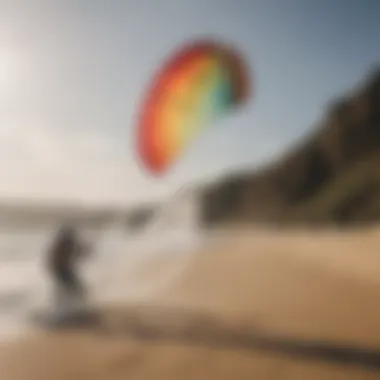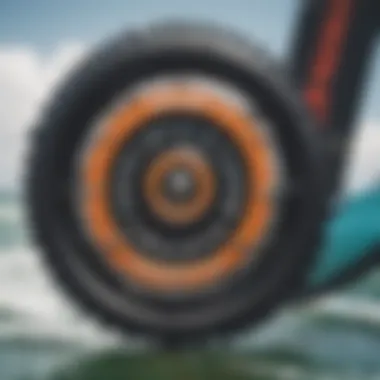In-Depth Torque Analysis for Kiteboarding Gear


Intro
Kiteboarding, a thrilling fusion of wind, water, and human skill, hinges heavily on a foundational concept known as torque. This hidden force operates at the core of maneuvering a kite. Understanding torque not only enriches the experience but also fine-tunes the rider’s skills and choices, making it essential for anyone passionate about kiteboarding.
In this exploration, we dive into the physics behind torque and how it shapes a kite’s behavior in the air. The interplay between torque and kite control has profound implications—especially as riders push the limits of what's possible. From seasoned instructors to eager novices, there’s something in here for everyone.
Ready yourself as we traverse from basic techniques to gear reviews, all woven together by the common thread of torque. Grasping this concept can transform one's approach to riding, resulting in significant improvements in technique and enjoyment. Let’s get into it.
Techniques
Beginner Kiteboarding Techniques
Kiteboarding for the first time can be exhilarating, yet it can bring a dose of complexity. When it comes to torque, grasping the basics helps in building a solid foundation. One of the fundamental techniques involves the body positioning relative to the kite’s pull. Proper stance can determine how efficiently torque is leveraged during maneuvers.
- Posture: Keep your knees slightly bent and your body in a neutral position. This eases the twisting motion required for initiating turns.
- Kite Positioning: When starting off, hold the kite at about 45 degrees. This angle creates a balance of lift and pull, helping to control torque effectively.
- Edge Control: Use your board’s edge to manage speed. Lean into your edge while managing the kite’s pull to maximize torque control, setting the stage for more advanced tricks.
Advanced Freestyle Maneuvers
As riders gain confidence and proficiency, exploring advanced freestyle maneuveres opens up a new world of expression. Here, torque is both an ally and an essential component of executing spectacular tricks. To harness its full potential:
- Handle Passes: These complex moves require acute torque management to spin the body while simultaneously passing the kite handle. Timing the pull and position is key.
- Air Tricks: In aerial maneuvers such as jumps and spins, understanding how torque acts on your body during rotation allows for smoother transitions and landing techniques.
- Transition Turns: In freestyle, sharp transitions are crucial. A controlled transition relies on tipping your board just right to carve smoothly through the water while using the kite’s pull to maintain torque.
This combination of beginner techniques and insights into advanced maneuvers can greatly enhance kiteboarding skills. Each turn, jump, and transition brings you closer to mastering the essential force of torque.
Gear Reviews
Latest Kiteboarding Equipment
In the ever-evolving world of kiteboarding, staying updated with the latest gear is paramount. Well-designed equipment can significantly influence how torque is experienced and managed. Noteworthy advancements include:
- Kites: Modern kites have been engineered to optimize lift and stability, aiding in torque control. Models like the Duotone Neo or the Ozone Edge cater to diverse riding styles and conditions.
- Boards: The design of a kiteboard impacts how it interacts with the wind. Lightweight boards, such as the Slingshot Misfit, provide excellent responsiveness, making it easier to maneuver and harness torque efficiently.
- Bindings: Adjustable bindings, like those found in the Liquid Force range, ensure greater control. They allow riders to personalize the feel, crucial for achieving the right torque in various positions.
Essential Accessories for Kiteboarders
While the kite and board are crucial, don’t overlook the smaller accessories that impact ride quality. A well-rounded kit includes:
- Helmets: Safety should come first. A robust helmet protects from falls while ensuring you remain focused on harnessing that torque.
- Impact Vests: Consider investing in a vest designed for impact absorption. This adds an extra layer of safety during jumps and tricks, allowing you to push your limits without compromising well-being.
- Bar and Lines: The control bar plays a fundamental role in managing torque. A good bar setup like the Cabrinha Overdrive gives better feedback on the kite’s responsiveness.
"Understanding torque is like unlocking a hidden level in a video game. It’s the difference between a novice and a pro."
Grasping the significance of torque deeply influences both the choice of gear and riding finesse. Making informed decisions based on your experience level will undoubtedly lead to a more gratifying and thrilling kiteboarding adventure.
Understanding Torque in Kiteboarding
When it comes to kiteboarding, the term "torque" carries practical weight, influencing not only the performance of the kite but also how a rider interacts with the equipment. This understanding goes beyond mere definitions; it taps into the adrenaline-pumping experience of gliding across water while directing the kite to maneuver smoothly through the wind.
Torque, defined as a rotational force, plays a pivotal role in a kite's ability to turn, lift, and balance. Recognizing how torque influences these factors can transform a rider’s approach to their craft. For kiteboarders, a grasp on torque is crucial for maximizing performance during those exhilarating rides and ensuring a safer experience.
The Physics of Torque
At its core, the physics of torque involves a fundamental connection between force and distance, which can make or break a kiteboarder's technique.
In practical terms, torque is generated when the kite, through its lines, exerts pressure on the rider. This pressure can be visualized as a lever arm, where the longer the arm, the more torque can be developed. For kiteboarding enthusiasts, this translates into an ability to more effectively change directions and adjust the elevation of their kite.
The key equation might be illustrated as:
Torque (τ) = Force (F) × Distance (d)
This means that the rider’s ability to pull harder on the lines (applying force) can raise the kite higher (distance), manifesting in heightened maneuverability. However, it’s essential to balance these elements; too much force can lead to loss of control, while too little may not achieve necessary lift. This balance is pivotal in technique adjustment, particularly during tricky maneuvers, like sharp turns or jumps.
While the math might seem dry at first glance, the reality on the water is anything but. Riders that grasp the impact of torque can significantly enhance both their technique and their enjoyment, capable of executing more responsive movements.
Torque's Role in Kite Maneuverability
Moving from the abstract concept of physics to its real-time application, torque has a monumental effect on kite maneuverability. It governs how a rider navigates through various situations, essentially dictating how gracefully or abruptly a kite responds to inputs.
- Turning:
- Elevation Gain:
- Speed Control:
- The more torque applied when steering the kite, the sharper and more controlled the turn will be. Skilled kiteboarders understand that subtle adjustments in line tension can produce substantial variations in turning radius.


- A well-tuned application of torque is crucial when a rider wants to ascend. The effective pull on the lines creates an upward force, allowing the kite to exploit the wind currents far more efficiently.
- Torque also impacts a kiteboarder’s ability to manage their speed. Faster movements can lead to increased torque demands; managing tension on the lines permits riders to control their velocity.
As riders become attuned to how their movements steer the kite’s efficiency, they can optimize their performance. A detailed understanding of torque enables more command over the kite, allowing riders to enter a fluid state where their actions translate seamlessly into flight.
In summary, a comprehensive grasp of torque’s forces and applications provides kiteboarders both the finesse and skill to take their riding to the next level. By grasping these principles, enthusiasts can not only enhance their skills but also appreciate the mechanics behind every exhilarating maneuver.
Technical Aspects of Torque
Understanding the technical aspects of torque in kiteboarding is essential for riders looking to harness the full potential of their equipment. Torque affects everything—from the way a kite maneuvers in the wind to how a rider can effectively control their movements. This section dives deep into the calculations used to determine torque and the forces at play that every kiteboarder needs to consider.
Torque Calculation: Formulas and Metrics
Calculating torque involves understanding the relationship between force and distance. The formula for torque ( T) is typically expressed as:
[ T = F \times r ]
Where:
- T is torque,
- F is the applied force,
- r is the distance from the pivot point.
In kiteboarding, this can translate to how forceful the wind hits the kite and how far the line connection point is from the rider. By realizing how these factors interplay, kiteboarders can adjust their techniques and gear for improved performance.
A crucial aspect of torque metrics is the need to account for different variables, such as rider weight and kite size. Understanding these metrics allows riders to make informed choices about gear compatibility, ultimately enhancing their control and overall kiteboarding experience.
Understanding Forces at Play
Wind Resistance
Wind resistance is a significant factor influencing torque in kiteboarding. It can be described as the opposing force that acts against the direction of travel, and it functions based on both the rider's speed and the surface area of the kite. An important characteristic of wind resistance is that it creates drag, which can directly impact trajectory and speed.
When a kite is designed with sleek shapes and materials, it reduces the drag, thus allowing the rider to maintain speed and stability. This aerodynamic quality makes a kite capable of harnessing the wind effectively and helps in executing sharper turns. However, if too much drag is present, it can be challenging for the rider to maneuver, resulting in less agile moves and potentially more difficulty in maintaining control.
"A kite that handles wind resistance well can be the difference between slicing through the waves or getting yanked back by the breeze."
Rider Weight Distribution
Rider weight distribution is another critical component when discussing torque in kiteboarding. It refers to how the rider balances their weight while in motion. A vital characteristic here is the role gravity plays in controlling the board’s trajectory and turning capabilities. By adjusting their stance and center of gravity, riders can influence the torque created by their kite.
For instance, by leaning forward when gearing up for a jump, a rider can enhance the downward force on the board. This allows for a quicker, more explosive lift, thus capitalizing on the torque generated through the kite's pull. This unique feature emphasizes the importance of proper weight distribution for optimal performance. However, if a rider is too far back on the board, it may create an unbalanced lift, causing instability and a potential wipeout.
Gear Review: Impact of Torque on Performance
When considering the performance of kiteboarding, understanding torque is like having the secret sauce in your recipe for success. The interplay of torque with gear design and setup significantly influences how a kite handles and responds under various conditions. This section aims to unpack the relationship between torque and the essential gear components, enabling riders to refine their performances on the water.
Kite Design and Torque Efficiency
Shape and Size Considerations
The shape and size of your kite are fundamental factors that affect torque efficiency. Kites come in various shapes, from flat to curved or even delta designs. Each shape contributes differently to how torque generated by wind interacts with the kite. For instance, a broader kite surface allows for more lift, reducing the need for a strong pull. This balance helps in maneuverability and control.
A popular trend among serious riders is the use of tapered shapes. Tapered kites have a narrow leading edge transitioning into a wider rear. This design facilitates smoother air flow, thereby generating better torque efficiency. The unique feature of the tapered kite is its ability to facilitate tighter turns without excessive effort from the rider. However, a key consideration is that smaller or more compact kites may lack the power needed for performance in lighter winds, thus making size an essential component of your decision.
Material Impact on Torque
The materials used in kite construction also play an essential role in torque. High-quality ripstop nylon and Mylar are common choices. These materials enhance durability, which directly impacts torque through their ability to maintain aerodynamic shapes under pressure.
A defining characteristic of advanced kite materials is their lightweight nature, enabling the kite to respond swiftly to rider inputs. For instance, when the wind picks up, a lighter kite can dive and turn much faster, translating wind energy into usable torque. Nevertheless, while lighter materials provide substantial benefits, they may not withstand heavy impacts as well as their heavier counterparts, particularly in rough conditions.
Bar and Line Setup
Line Length and Torque
Another crucial aspect affecting torque in kiteboarding is the line length. Longer lines can mean more distance from the kite to the rider, which can help in creating a smoother ride and more drift. However, the relationship with torque can be tricky. Longer lines require more precision in control and may diminish the immediate responsiveness one might expect from a kite.
The, general preference among seasoned riders is to adjust line length to suit the wind conditions. In lighter winds, shorter lines provide better torque response, allowing for quicker turns and movements.
Adjustable Bars: Benefits
Adjustable bars have become quite popular, offering riders a chance to tailor their setups according to personal preference and conditions. The main benefit here is versatility. Adjustable bars allow for different widths—wider for more control, narrower for enhanced responsiveness.


The unique feature of these bars lies in their ability to ease the rider’s workload. By providing the option to alter the distance between the hands and the kite's pull, it directly influences torque management. However, the downside can be the complexity in setup, with inexperienced riders sometimes struggling to find the ideal configuration without adequate guidance.
Harness Technology and Torque Management
Harness systems are another component that can greatly influence how torque is utilized and managed. Modern harnesses are designed for optimal weight distribution and comfort, allowing riders to maintain a steady posture against the forces at play. Investing in a quality harness can greatly improve how effectively one can ride against the pull, translating to more efficient energy use on the water.
A good harness, like the Mystic Majestic Series, often features padding and a rigid structure, aiding in the transfer of torque from the kite to the body. Such technologies can facilitate greater endurance, allowing riders to push their limits without discomfort.
Keeping the harness in top shape through routine checks is paramount. Any wear and tear could lead to performance issues, inadvertently affecting torque management on the water.
Expert Opinions on Torque and Kiteboarding
Understanding torque is crucial for kiteboarding enthusiasts. It’s not just about catching the wind; it’s about how effectively you can translate that force into movement and control. In this section, we delve into insights from professionals in the field. These perspectives shed light on how torque influences performance, safety, and overall enjoyment of the sport.
Interviews with Professional Riders
Interviews with experienced kiteboarders reveal the nuances of how they perceive and utilize torque during their sessions. Top riders often discuss their personal techniques for maximizing torque to enhance their maneuvers on the water.
For instance, Jake, a seasoned pro from Hawaii, explains,
"The way I use the kite's pull is all about understanding the torque generated during a turn. It’s not just about strength but also about timing and precision. When I snap the kite over my head, I'm literally harnessing the wind's rotation through the torque applied on the lines—it's magic."
This showcases how professional riders tap into the fundamental principles of torque to achieve stellar performances. Other riders emphasize body mechanics and how shifting weight can help adjust the torque on the kite. For them, understanding torque becomes second nature, as they continually adapt their riding style based on wind conditions and equipment.
Insights from Gear Designers
Gear designers play a pivotal role in how torque dynamics are incorporated into kiteboarding equipment. Their insights reveal essential elements regarding how gear can significantly impact torque effectiveness.
Designers like Sara from a prominent kite company emphasizes the importance of shape and material in kite construction. She notes,
"The design of a kite can enhance or hinder a rider's ability to manage torque. A wider arc might give more lift but less control when you turn. It’s about finding that balance—each element from the fabric to the shape must work in harmony."
Additionally, they discuss the evolution of equipment. New materials provide a lighter and more responsive feel, allowing riders to manipulate torque more efficiently.
- Key Takeaways from Gear Designers:
- Material Selection: Lighter materials increase responsiveness.
- Kite Shape: A well-balanced design affects torque just as much as rider technique.
- User Feedback: Listening to riders helps refine gear performance directly related to torque management.
This section emphasizes that both professional riders and gear designers view torque not only as a fundamental concept but as a pivotal element in elevating the sport of kiteboarding. Their shared experiences and insights help bridge the gap between theory and practical application, ensuring a well-rounded understanding of how to optimize performance in the water.
Practical Applications of Torque in Kiteboarding
Understanding torque isn’t just a theoretical exercise; it’s a practical cornerstone that shapes how kiteboarders navigate the waters. The nuances of torque influence performance in a myriad of ways, making it essential for both budding enthusiasts and seasoned pros to grasp its real-world implications.
Torque impacts everything from tracking straight in light winds to executing sharp turns in choppy conditions. By mastering the practical aspects of torque, riders can enhance their overall experience, ensuring they make the most of their kiteboarding sessions.
Adjusting Technique for Optimal Torque Use
Body Positioning
Body positioning is a fundamental technique every kiteboarder should focus on to maximize torque efficiently. When riders position their bodies closer to the board’s center or shift their weight appropriately, they can create a more direct transfer of energy from the kite to the propulsion of the board. The key characteristic here is the way the rider attains balance with a slight lean, aligning their weight over the board's edge.
This approach becomes a popular choice, particularly during high-speed maneuvers or sharp turns. The unique feature of proper body positioning lies in its adaptability—all it typically takes is shifting the hips or adjusting one’s stance to maximize torque utilized effectively. However, neglecting this aspect may lead to misalignment, causing the board to slip or lose grip in the water, diminishing overall control.
Controlled Turns and Jumps
Controlled turns and jumps are another vital area where optimal torque usage reveals its significance. Properly executing these moves can significantly enhance a rider's performance and enjoyment. Here, the connection between body movement and the kite's power becomes most evident. The key characteristic of mastering controlled turns lies in utilizing torque to carve smoothly rather than forcing a sudden shift. This not only maintains momentum but amplifies the thrill of kiteboarding.
The unique feature of executing controlled turns is that it allows riders to remain in sync with wind patterns. Mastering this technique means riders can anticipate shifts and remain responsive. However, overly aggressive turns may sap energy quickly and lead to instability, potentially causing wipeouts.
Routine Maintenance for Torque Performance
Inspecting Gear Integrity
Regular inspection of gear integrity is crucial for maintainig torque performance across all conditions. Making sure that lines, kites, and boards are in tip-top shape ensures a predictable response and maximizes the effectiveness of torque during riding sessions. The key characteristic of this aspect is its preventative nature—by routinely checking for wear or damage, riders can nip potential issues in the bud.
The unique feature of this practice is its holistic approach. It goes beyond the obvious visual cues; checking for frays in lines or tiny punctures in the kite can help avoid significant problems down the line. Ignoring gear integrity can result in a lack of control, critically compromising performance, especially when torque is paramount.
Upgrades and Modifications


Upgrades and modifications are where a kiteboarder can really make their gear work for them. This could be anything from switching to a new type of fin or experimenting with different kite shapes to optimize torque performance. The key characteristic of this practice is the potential for personalization; riders can tailor their setup to suit their individual style and the conditions they frequent.
One unique benefit of various modifications is improved responsiveness. For instance, if a rider swaps traditional lines for a lighter material, they might notice their kite reacts faster to input. However, it's important to tread carefully: some mods may trade off stability for improved torque, particularly in gusty conditions or when navigating choppy waters. Riders need to weigh these aspects thoughtfully.
Comparative Analysis of Torque in Various Conditions
Understanding the torque dynamics within kiteboarding relative to varying external conditions can greatly enhance performance and enjoyment. This analysis provides a roadmap for riders, enabling them to optimize techniques, adapt gear settings, and ultimately improve their overall kiteboarding experience. The essence of torque, influenced by both wind conditions and water surface type, shapes the rider's every move. By distinguishing how these factors intertwine, kiteboarders can harness the full potential of their setups under different scenarios.
Different Wind Conditions and Torque
Wind acts as the primary force in kiteboarding, dictating how riders interact with their kites and the water. Differentiating techniques based on wind strength is pivotal for any kiteboarding enthusiast.
Light Wind Techniques
Light wind scenarios require a unique approach to torque management. In these conditions, riders typically use larger kites to capture more wind.
- Key characteristic: Larger surface area.
- Benefit: The increased lift allows for smoother gliding, making it easier to cruise.
- Unique feature: Techniques such as efficient edging and the usage of lighter boards can elevate performance, enabling a rider to utilize the available wind constructively.
Although light wind techniques enable more enjoyable sessions, they come with some trade-offs.
- Advantages: Greater control in low winds, adaptability.
- Disadvantages: Reduced jumping and speed potential due to lack of strong wind, requiring riders to refine their skills in baiting and maneuvering the kite effectively.
High Wind Considerations
In contrast, high wind scenarios demand a more aggressive approach to torque dynamics. Riders often opt for smaller kites that provide a drier experience, improving response time and control in gusty conditions.
- Key characteristic: High stability with reduced size.
- Benefit: Smaller kites require less strength to manage, allowing for intricate maneuvers.
- Unique feature: Use of more robust lines and a tighter control bar setup helps manage the torque effectively in these stronger winds.
However, high wind conditions also present challenges.
- Advantages: Enhanced speed and the ability to perform thrilling jumps and tricks.
- Disadvantages: High winds can introduce a level of unpredictability, resulting in potential difficulties for less experienced riders.
Impact of Water Surface on Torque Dynamics
Water surface conditions significantly impact how torque affects kiteboarding, as varying textures change the interaction between the board and the water.
Flat Water vs. Choppy Water
Flat water conditions provide an ideal setting for refining techniques and maximizing torque use. Here, riders can maintain better speed and execute smoother transitions without the interference of additional wave dynamics.
- Key characteristic: Consistency and predictability in surface behavior.
- Benefit: Riders often find it easier to sustain high speeds and perform advanced tricks.
- Unique feature: Flat water allows more precise angle adjustments and kite control during jumps and landings.
On the contrary, choppy water introduces a fresh layer of complexity that requires adjustment in the rider's approach to torque management.
- Advantages: Ability to adapt to variable conditions, enhancing overall skill.
- Disadvantages: Increased risk of losing speed and control during maneuvers, as the board can bounce or lose traction more easily.
Wave Riding Adjustments
When tackling wave riding, adjustments to technique and gear become apparent. Riding the waves fundamentally alters how torque influences the board’s movement and rider's balance.
- Key characteristic: Heightened focus on balance and timing.
- Benefit: Effective torque management allows for carving through waves, navigating swells, and enhancing overall thrills.
- Unique feature: Use of specific kite designs that maximize lift and stability in moving water settings can dramatically impact ride quality and rider confidence.
The allure of wave riding is coupled with its challenges.
- Advantages: Excitement and visual rewards from riding dynamic elements of nature.
- Disadvantages: The learning curve can be steep as navigating properly through waves requires a solid grasp on timing and technique.
Prioritizing the understanding of torque in various conditions allows kiteboarders to develop an adaptable skill set, enabling effective riding irrespective of external elements.
Through this comparative analysis of different environmental factors, enthusiasts can master their trade and ride with confidence, embracing the full spectrum of sensations that kiteboarding offers.
Finale and Future Directions
As we wrap up this comprehensive look into torque and its pivotal role in kiteboarding, it's essential to reflect on the significance of understanding these concepts. They are not just theoretical; they translate directly into enhanced performance on the water. By grasping the nuances of torque, kiteboarders can make informed choices about gear and adjust their techniques accordingly. This knowledge can lead to better control, more efficient movements, and ultimately, a more exhilarating experience while navigating the waves.
Summarizing Key Findings
Throughout this article, we dove deep into several critical areas regarding torque in kiteboarding:
- The Physics of Torque: We explored how torque is fundamentally tied to the forces at play when a kite is flown. Understanding this can help riders optimize their control during maneuvers.
- Gear Components: The impact of various gear types on torque management was discussed, emphasizing how kite design, bar length, and harness technology can influence a rider's performance.
- Wind and Water Dynamics: We analyzed how different wind conditions and water surfaces interact with torque, affecting rider experience. Light winds require a different approach compared to strong gusts or choppy waters.
The key takeaway here is that torque is not merely a measurement—it's a vital element that defines how effectively a kiteboarder can navigate their environment. Riders who comprehend these principles can significantly enhance their skills and enjoyment on the water.
Emerging Trends in Kiteboarding Gear
Looking ahead, the kiteboarding industry is experiencing innovative shifts, particularly regarding gear designed to enhance torque management. Here are some notable trends:
- Smart Technology Integration: More manufacturers are incorporating smart technology into kites and harnesses. GPS data, performance metrics, and automatic adjustments can increase efficiency and adaptability.
- Material Advancements: New materials that offer lighter weight and increased durability are on the rise, contributing to better torque dynamics. For instance, fabrics with enhanced tensile strength can improve a kite's response and handling.
- Customized Setup Options: There's a growing trend towards customizable gear that allows riders to tweak their setups based on specific conditions. Adjustable lines, modular bars, and personalized harnesses enable users to optimize torque to their liking.







